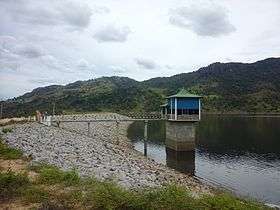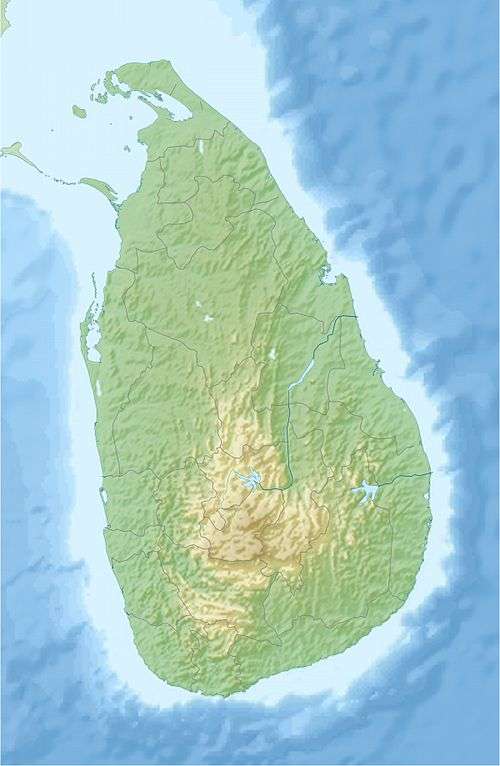Rambakan Oya Dam
| Rambakan Oya Dam | |
|---|---|
 | |
 Location of Rambakan Oya Dam in Sri Lanka | |
| Country | Sri Lanka |
| Location | Maha Oya |
| Coordinates | 7°27′4.85″N 81°24′20.47″E / 7.4513472°N 81.4056861°ECoordinates: 7°27′4.85″N 81°24′20.47″E / 7.4513472°N 81.4056861°E |
| Purpose | Irrigation and Domestic water supply |
| Status | Operational |
| Construction began | 12 February 2007 |
| Opening date | 20 July 2013 |
| Owner(s) | Ministry of Irrigation |
| Dam and spillways | |
| Type of dam | Earthen dam |
| Height | 24.7 m (81 ft) |
| Length | 1,225 m (4,019 ft) |
| Width (crest) | 7 m (23 ft) |
| Spillways | 2 |
| Spillway type | Radial Gate |
| Spillway capacity | 554.75 m3/s (19,591 cu ft/s) |
| Reservoir | |
| Creates | Rambakan Oya Reservoir |
| Total capacity | 56,000,000 m3 (2.0×109 cu ft) |
| Catchment area | 129.5 km2 (50.0 sq mi) |
The Rambakan Oya Dam is an embankment dam in Maha Oya, Eastern Province, Sri Lanka. The reservoir was designed and constructed by the Sri Lanka Mahaveli Authority and currently functions under the direction of the Ministry of Irrigation and Water Resources Management.[1] It have been created by building an Earthen dam of which is about 1225m in length across the river of Mundeni Aru.[2]
The Rambakan Oya reservoir project is a multipurpose irrigation project which is commissioned to find a solution for the drinking water issue and irrigation problems in the area.[3] It is the 10th zone of Mahaweli Development scheme and located bordering Badulla, Monaragala and Ampara districts.[4]
History
Ancient time
There are archaeological evidences, those reveals about previous attempts to construct an irrigation tank here during the ancient time periods.[5] According to them there are different legends and archaeological views on ancient construction of Rambakan Oya Reservoir. It is believed that construction of Rambaken Oya Reservoir was commenced by prince Giri Abaya who ruled the East, in third century, B.C. According to some other historical evidences it was commenced by Prince Saddhatissa (137-119 BC).
Ruins

There is a one-mile longed old earthen dam can be seen, near to the newly constructed dam. It was constructed between Gorikanda and Galkanda with rip rap, in high quality. Around 250 feet long dressed stones made to use for the twin Barrel Sluice are still remaining in surrounding. Any way there is no evidence to prove that the construction was completed or the reservoir was functioned.
Near to the old Sluice, a stone slab inscription belonging to 12th – 13th centuries can be seen and which identified as Rambakan Oya Slab Inscription. It describes that the stone canal was built by Liyana Nayakayan and Kanathkan Vahanse, who lived in the Gal Weta area.[6]
Recent project
The recent project to develop the Rambakan Oya reservoir was commenced on 12 February 2007[7] and the opening ceremony was held on 20 July 2013 with the participation of then Sri Lanka President Mahinda Rajapaksa and Irrigation and Water Resources Management Minister.[8]
See also
References
- ↑ "Rambukkan Oya Reservoir". development.lk. 22 July 2013. Retrieved 10 November 2015.
- ↑ "Rambukkan Oya". Irrigation Departmaent. Retrieved 10 November 2015.
- ↑ "Rambaken Oya reservoir built with local expertise, commissioned". asiansun.lk. Retrieved 10 November 2015.
- ↑ "Rambaken Oya Project". news.lk. 6 October 2011. Retrieved 10 November 2015.
- ↑ "Rambakanoya Tank-Rambakan Oya Old Construction". srilankatravelnotes.com. Retrieved 10 November 2015.
- ↑ "Rambakan Oya Ruins of Ancient Granite Canal – අම්පාර රඹකැන් ඔය ගල් ඇල". amazinglanka.com. Retrieved 10 November 2015.
- ↑ Naalir Jamaldeen (21 July 2013). "Rambakan Oya irrigation project commissioned". sundayobserver.lk. Retrieved 10 November 2015.
- ↑ "Rambakan Oya Multipurpose Irrigation Project:'Landmark in country's irrigation history'". dailynews.lk. 2 July 2013. Retrieved 10 November 2015.
External links
- "Rambakan oya tank". geoview.info. Retrieved 10 November 2015.
- "Projects-Rambakan oya". Irrigation Department, Sri Lanka. Retrieved 10 November 2015.